
Fernando Consag, known in his native Croatian as Ferdinand Konščak, was a Croatian Jesuit missionary, explorer and cartographer, who spent most of his life in Mexico, in Baja California.

Francisco Hermenegildo Tomás GarcésO.F.M. was a Spanish Franciscan friar who served as a missionary and explorer in the colonial Viceroyalty of New Spain. He explored much of the southwestern region of North America, including present day Sonora and Baja California in Mexico, and the U.S. states of Arizona and California. He was killed along with his companion friars during an uprising by the Native American population, and they have been declared martyrs for the faith by the Catholic Church. The cause for his canonization was opened by the Church.
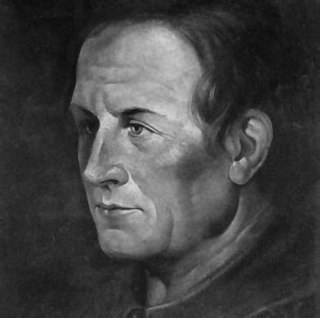
Father Eusebio Francisco Kino, SJ, often referred to as Father Kino, was an Italian Jesuit, missionary, geographer, explorer, cartographer, mathematician and astronomer born in the Territory of the Bishopric of Trent, then part of a partially German-speaking area of the Holy Roman Empire of the German Nation. For the last 24 years of his life he worked in the region then known as the Pimería Alta, modern-day Sonora in Mexico and southern Arizona in the United States. He explored the region and worked with the indigenous Native American population, including primarily the Tohono O'Odham, Sobaipuri and other Upper Piman groups. He proved that the Baja California Territory was not an island but a peninsula by leading an overland expedition there. By the time of his death he had established 24 missions and visitas.
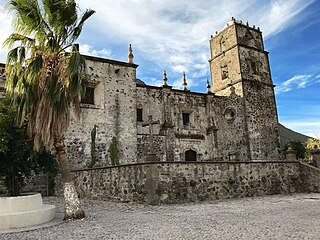
Misión San Francisco Javier de Viggé-Biaundó was a Spanish mission in San Javier, Baja California Sur, on the Baja California peninsula. It was built during the colonial era of the Viceroyalty of New Spain. The site is in present-day Loreto Municipality of Baja California Sur state. The mission was located at 25°51′38″N111°32′37″W. San Francisco Javier mission was founded by Jesuits of the Roman Catholic church in 1699 and closed in 1817.

Francisco Javier Clavijero Echegaray was a Mexican Jesuit teacher, scholar and historian. After the expulsion of the Jesuits from Spanish provinces in 1767, he went to Italy, where he wrote a valuable work on the pre-Columbian history and civilizations of Mesoamerica and the central Mexican altiplano.
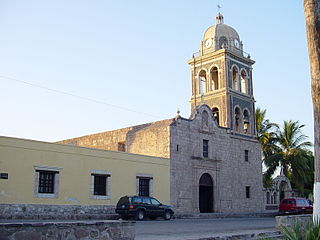
Misión de Nuestra Señora de Loreto Conchó, or Mission Loreto, was founded on October 25, 1697, at the Monqui Native American (Indian) settlement of Conchó in the city of Loreto, Baja California Sur, Mexico. Established by the Catholic Church's Jesuit missionary Juan María de Salvatierra, Loreto was the first successful mission and Spanish town in Baja California.
Mission San Fernando Velicatá was a Spanish mission located about 56 km (35 mi) southeast of El Rosario in Baja California, Mexico. The mission was founded in 1769 by Franciscan missionary Junípero Serra and was the only mission founded by Franciscan missionaries in what is now Baja California.
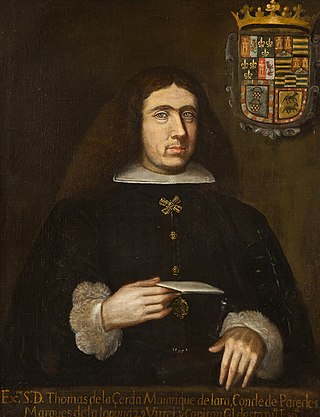
Tomás de la Cerda y Aragón, 3rd Marquess of la Laguna de Camero Viejo, GE, KOA, , was a Spanish nobleman, viceroy of Galicia and of New Spain from 1680 to 1686. He is better known as the Count of Paredes, though he held this title only as consort.

Italian Mexicans are Mexican-born citizens who are fully or partially of Italian descent, whose ancestors were Italians who emigrated to Mexico during the Italian diaspora, or Italian-born people in Mexico. The ancestors of most Mexicans of Italian descent arrived in the country during the late 19th century. Their descendants have generally assimilated into mainstream Mexican society.

The Spanish missions in Baja California were a large number of religious outposts established by Catholic religious orders, the Jesuits, the Franciscans and the Dominicans, between 1683 and 1834. The missionary goal was to spread the Christian doctrine among the Indigenous peoples living on the Baja California peninsula. The missions gave Spain a valuable toehold in the frontier land, and would also act as a deterrent to prevent pirates from using the peninsula of Las Californias as a jumping off point for contraband trade with mainland New Spain. Missionaries introduced European livestock, fruits, vegetables, and industry into the region. Indigenous peoples were severely impacted by the introduction of European diseases such as smallpox and measles; furthermore, the expulsion of the Jesuits from the Spanish Empire in 1767 ripped the social fabric of the peninsula, although Franciscans were sent to replace them. In 1769, the Franciscans moved to Upper California, leaving Dominicans in charge of Baja California. By 1800 indigenous numbers were a fraction of what they had been before the arrival of the Spanish, yet even today many people living in Baja California are of indigenous heritage.
Croatian Americans or Croat Americans are Americans who have full or partial Croatian ancestry. In 2012, there were 414,714 American citizens of Croat or Croatian descent living in the United States as per revised 2010 United States Census. The figure includes all people affiliated with United States who claim Croatian ancestry, both those born in the country and naturalized citizens, as well as those with dual citizenship who affiliate themselves with both countries or cultures.
Mission San Bruno was a short-lived Spanish mission established by Jesuit order on October 7, 1684, in what is now the Loreto Municipality of Baja California Sur, Mexico. The mission was the first Spanish mission established on the Baja California Peninsula.

Fernando Javier Rivera y Moncada was a Mexican-born soldier of the Spanish Empire who served in The Californias, the far north-western frontier of New Spain. He participated in several early overland explorations and later served as third Governor of The Californias, from 1774–1777.

Ivan Ratkaj, also Ivan Rattkay, was a Croatian Jesuit missionary, explorer and cartographer. He wrote the first detailed description of the Tarahumara, a Native Mexican people.
Juraj Ratkaj was a Croatian historian, priest and nobleman. Born in the Ratkaj Croatian noble family, barons of Veliki Tabor, he was a member of the Society of Jesus. Later on he became a priest and the canon of Zagreb. He took part in the Thirty Years' War in 1647 and fought the Ottomans as well. His best known work is Memoria regum et banorum regnorum Dalmatiae, Croatiae et Sclavoniae.

Croatia–Mexico relations are the bilateral relations between Croatia and Mexico. Both countries are mutual members of the United Nations. Neither country has a resident ambassador.
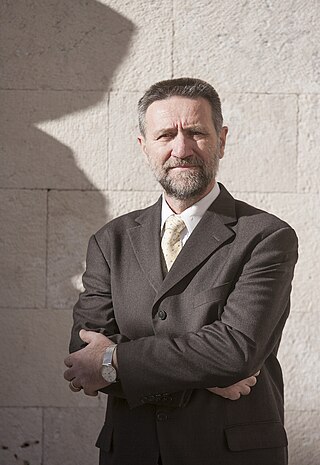
Pavo Barišić is a Croatian philosopher and politician who served as the Minister of Science and Education in the Cabinet of Andrej Plenković from 19 October 2016 until 9 June 2017. He publishes in the field of philosophy of law, politics and democracy, history of philosophy, and bioethics. He is a member of Croatian Democratic Union.

Bartol Sfondrati (1541—1583) was 16th century Jesuit missionary who is considered as the first Ragusan Jesuit. Sfondrati became a jesuit in 1569 after graduating law at the University of Pavia.
Tommaso Raggio (1531–1599) was a 16th century Jesuit missionary.

Province of Las Californias was a Spanish Empire province in the northwestern region of New Spain. Its territory consisted of the entire U.S. states of California, Nevada, and Utah, parts of Arizona, Wyoming, and Colorado, and the Mexican states of Baja California and Baja California Sur.















